
We recently surveyed our Carrot members about their lead-to-deal conversion rate — that is, what percentage of leads become deals. We also asked them about the source of these leads (Carrot leads or Non-Carrot) to determine which efforts provide the most high-quality leads and thus the most deals.

Demo Carrot: How many deals are you losing to your competitor’s website?
Take a Free DemoThe results were exciting. They indicated that Carrot leads convert 7 times better and are 2.5 times more profitable than non-Carrot leads.
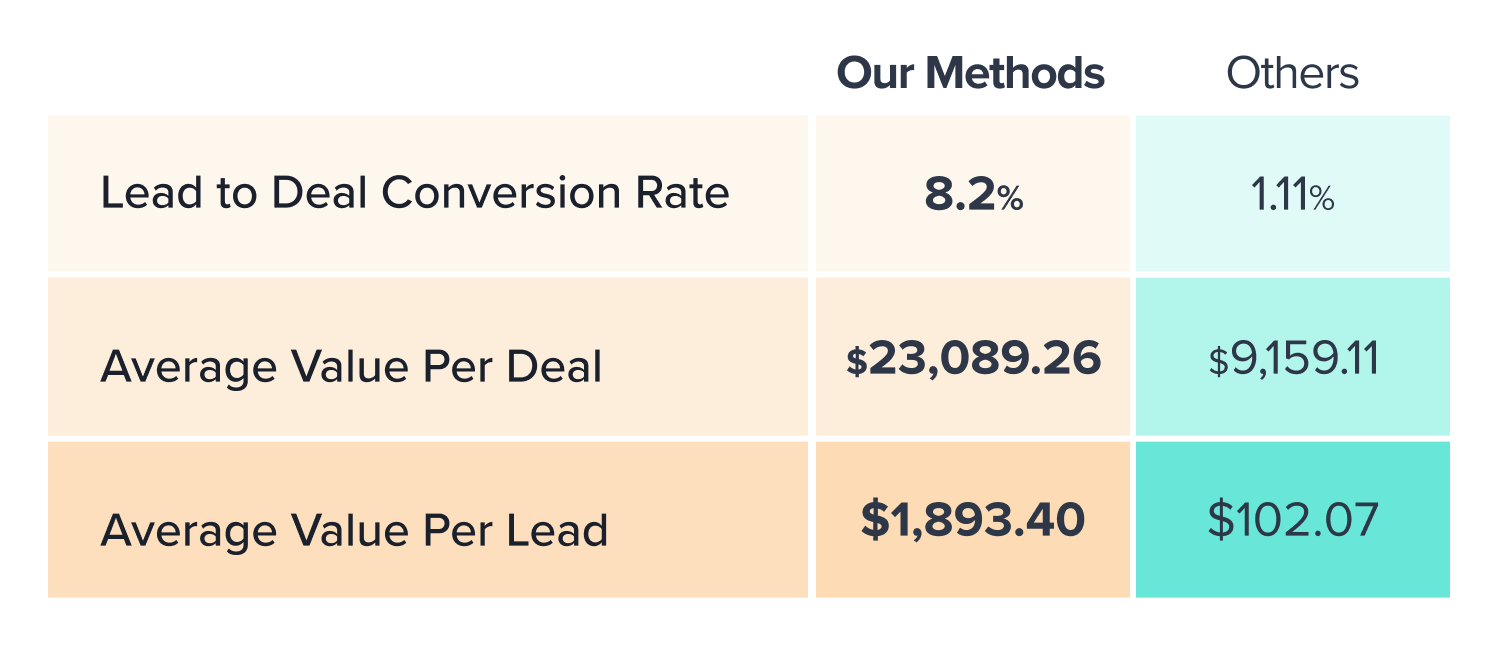
This is something we’ve known anecdotally for a long time — from all of the reviews we’ve received from our members. For example…
“Carrot literally changed my life. Trevor and his crew are the best people on the planet. Get plugged into their system and culture, and you will start generating leads!” – Brian Rockwell
“I have generated just over 200 leads in a little over 4 months using my Carrot site. I couldn’t be more thankful for the services they have provided. Thank you Carrot!” – Hank Tobler
“Closed 3 deals exclusively from SEO leads / Carrot conversions. No PPC. No attribution to any Facebook ads. Just Google search results and credibility.” – Daniel DiGiacomo
… but still, it’s refreshing to see the actual data.
Let’s take a look!
Not a Carrot member? Take a free demo…
The Survey Data & What it Means
To be clear, non-Carrot leads refer to any leads that didn’t come through an investor’s Carrot website. Maybe they called, texted, or emailed instead.
Carrot leads, naturally, refer to any leads that came through the investor’s website. They visited and opted into a CTA that looks something like this…
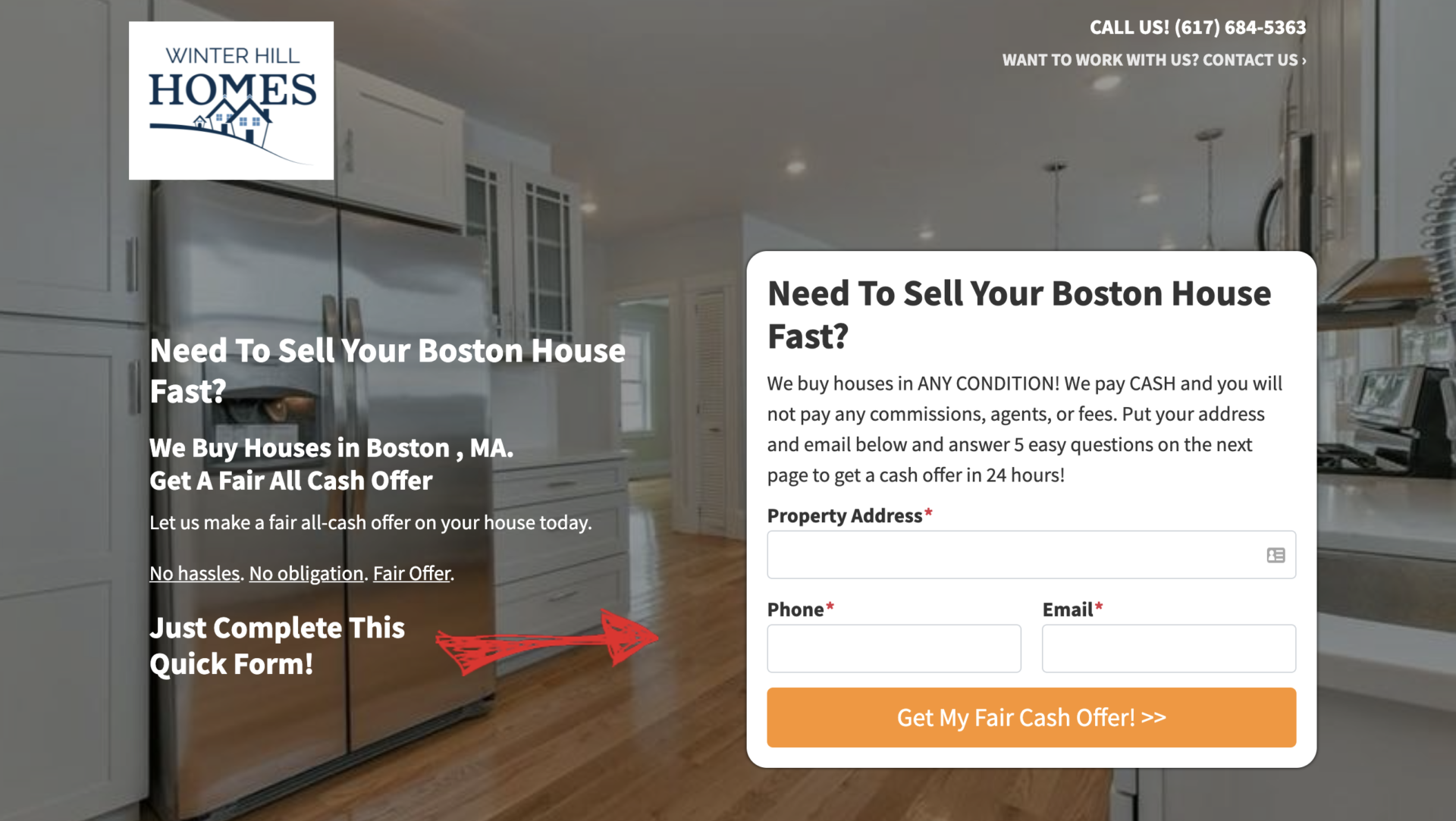
So, what exactly were the results?
Well, we asked Carrot members for their lead-to-deal conversion rate and their average value per deal for both Carrot and non-Carrot leads.
We then used those numbers to calculate the survey respondents’ average value per lead.
Here are the Carrot vs. Non-Carrot results:

Amazing, right?
Carrot leads had an 8.2% lead-to-deal conversion rate, while non-Carrot leads had a 1.11% conversion rate.
Even more surprisingly, Carrot leads that became deals had an average value of $23,089.26, and non-Carrot leads that became deals had an average value of $9,159.11.
That makes the average value per Carrot lead $1,893.40. That is enough to pay for an entire year of our top subscription plan, by the way! And, the average value per non-Carrot lead is $102.07.
Something is going on here, and let’s talk about that.
But before we do, understand that we’re not saying you shouldn’t generate leads one way, but you should generate them another.
Every real estate investor has to find what works for their business and their market, which usually is a mishmash of various marketing tactics.
Here, we’re just looking at some high-level trends that might be helpful for investors to consider.
Why are Carrot leads so much better than Non-Carrot leads?
There are essentially two questions we have to answer.
- Why do Carrot leads become deals much more frequently than non-Carrot leads?
- Why do Carrot deals have much bigger profit margins than non-Carrot deals?
And the first thing we need to examine is where these leads are coming from. After all, the source determines the quality.
Non-Carrot leads is a broad term that includes a lot of different sources: cold calls, inbound calls from direct mail campaigns and door knocking, flyers, business cards, bandit signs, and so forth.
You might not notice it at first, but all of those sources have a similarity: they all represent outbound marketing efforts.
That is, you go out and try to find people who might be interested in selling their home. You offer them a fair cash offer and a quick turnaround time. You do this by sending them mail, knocking on their door, or calling their phone.
Of the people who contact you via outbound marketing methods, it’s safe to assume that many of them are just curious. They’re not motivated to sell by any particular circumstances in their life, but your offer caught their attention, and so they call you to find out more.
That’s how most non-Carrot leads are generated.
Now let’s look at Carrot leads.
We’ve built Carrot websites with wicked-fast load speeds, mobile friendliness, and a clean tech stack.
Carrot sites rank for high-value phrases in Google more than any other site builder in the industry (terms like “sell my house fast in ” or “sell my house for cash in .”
Third-party data from Fresh Chalk pointed this out. Here are page speed scores for different website builders (a huge factor for Google rankings).
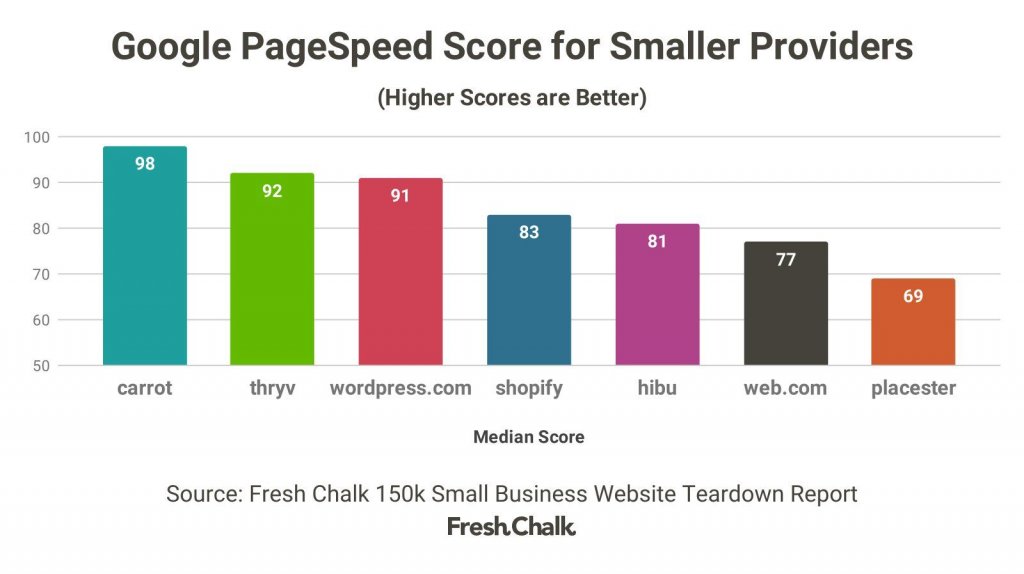
The same is true for Carrot’s mobile performance (which is now a huge part of internet traffic).
This graphic represents the recent updates that Carrot developers have made to our member sites to get ahead of the latest Google Core Web Vitals update. Learn more about what this graphic means and the changes that we made here.
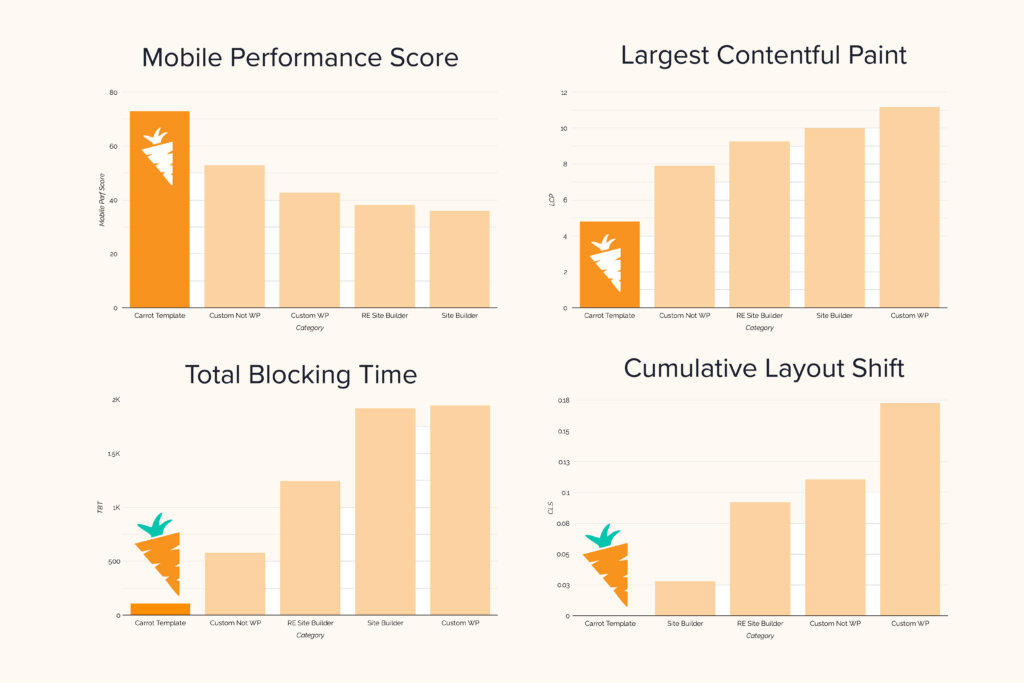
But that’s only one of the many reasons that Carrot sites sit at the top of the rankings.
The secret to quality lead mastery
Our members also create Evergreen content for their blogs every single month, content that’s optimized to rank in Google.
We also give our members the ability to:
- Track their rankings right inside of their account.
- Ensure that every page and post is optimized to rank (via a simple checklist).
- Create long-form evergreen content by transcribing video content with the click of a button (VideoPost).
- Publish weekly blog content with a click of a button.
- And so much more!
This is the difference between hamster wheel marketing…
“If you’re creating a piece of content and you just put it up on Facebook or Instagram, it’s going to be there for 24 to 48, maybe 72 hours before it gets pushed down, forcing you to get back on the hamster wheel and post again, and post again and post again, because the life span of that content is so short.
The lifespan of that content is so short that you have to be on the hamster wheel continually.
If you get off of the hamster wheel, if you stop doing those postings, if you stop doing direct mail, if you stop cold calling or doing RBMs, then your leads will eventually dwindle to a stop, and you’ve got to restart and get back on the hamster wheel.”
… and Evergreen Marketing…
“Get into a routine of creating content. Another piece of content this week, another piece of content next week, a blog post next week, a video post, a video post, a location page, and eventually, you’re going to have a brick wall that does all of the work for you.
Remember, it’s going to be slow going in the first three, four, five, six months potentially.
But as long as you’re consistently stacking bricks of quality content that answers real questions from your market, you’re entertaining in your own way; you’re going to start to pick up that momentum.”
At Carrot, we focus on evergreen marketing — consistent action that produces long-term results.
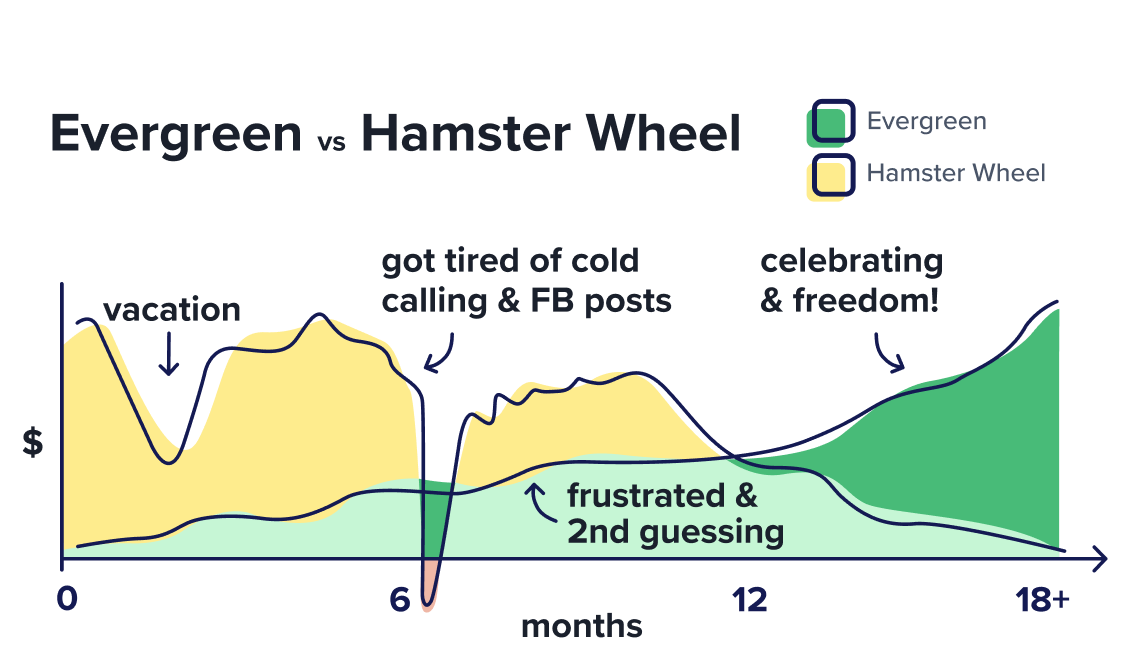
Now, why all of this information about Google rankings, page speed, and tech stack?
Well, because of the way Carrot sites are built, they typically generate a good chunk of leads via evergreen marketing through search engines like Google — this means that motivated sellers find you rather than you trying to find motivated sellers.
That’s called inbound marketing.
And it almost always results in higher quality leads than outbound marketing.
So that answers our first question.
Why do Carrot leads become deals much more frequently than non-Carrot leads?
There’s a high likelihood it’s because many of them are likely coming through search engines.
When you think about it, it’s not all that surprising that outbound marketing leads tend to be lower quality than inbound marketing leads. It’s the difference between you looking for motivated sellers and motivated sellers looking for you.
We get feedback about this difference all the time from our members…
“I consistently get organic leads from my Carrot website. I have purchased my best deals to date through my websites. I highly recommend you implement training and tools available through the platform.” – Beau Eckstein
“I’m getting 2x more motivated seller leads with my custom Carrot site than my old site, and the tools and content help me stand out in my crowded market.” – Tyler Ford
“I am saving between $20,000 and $50,000 every single month in lost lead-gen closing potential after switching from my expensive custom-made site to my Carrot site.” – Carter Steph
And it’s not just hearsay. When we take a peek at the source of traffic and leads for our members, we can see a good chunk coming from the organic content that Carrot helps to provide. So far, in 2021, organic traffic accounts for 25.8% of our member leads.

But what about the second question: why do Carrot deals have more significant profit margins than non-Carrot leads?
Part of the answer is likely the same as the first — since Carrot sites drive organic leads through search engines, investors don’t have to directly pay for those leads like they would have to with a direct mail campaign.
This makes a big difference in per-deal profitability. But that’s not the entire story.
Again, we have to look at where these deals come from.
If someone receives your mailer and it makes them think about selling a property that they’ve owned for a while, and so they call you, they’re probably not going to be as willing or motivated to accept a lower offer.
But if someone is actively looking for someone like you who can buy their home as-is for cash, they’re probably more motivated and thus more willing to accept a lower offer, which results in higher profit margins.
And so that answers our second question…
Why do Carrot deals have much bigger profit margins than non-Carrot deals?
It’s because inbound marketing efforts are less expensive and generate leads that are more motivated to accept lower offers.
Final Thoughts
If there’s a lesson to be learned from all this, it’s about the value of inbound marketing.
When you create an online presence that allows motivated sellers to find you, you can expect to generate much higher quality leads for less money and increase your per-deal profitability.
That’s not to say that you should stop sending direct mail, cold calling, door knocking or driving for dollars. We are huge advocates of those strategies, and they support many Carrot member businesses!
Perhaps a hybrid approach is best.
Steadily invest in your online presence. Create a high-converting real estate website, start search engine optimization, create new content, and so forth to build a long-term source of lead generation.
That will take time to start working.
While you’re working on SEO and content, you can also run PPC ads and send direct mail to generate leads more immediately for your business.
That’s the balanced approach that has worked for thousands and thousands of real estate investors, and there’s no reason that it won’t work for you, too.
Click below if you’re ready to take the next step.